ATHENS
THE CRADLE OF WESTERN CIVILIZATION

It helps keep this site running, and we appreciate your support!
Sightseeing
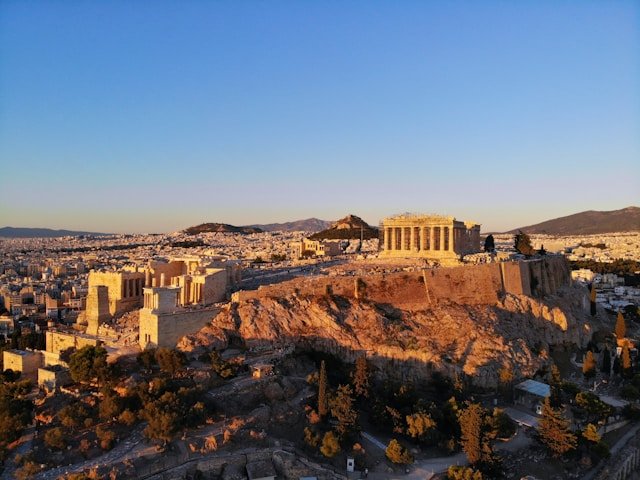
The Acropolis
Rising above Athens, the Acropolis is a rocky citadel crowned by ancient ruins, a symbol of Greece’s golden age. Built in the 5th century BC, it’s a UNESCO site where democracy and art bloomed. The climb’s steep but rewards with panoramic views—entry’s about $22 USD. Dusty paths and marble remnants evoke history’s pulse, making it a must-see despite summer crowds.
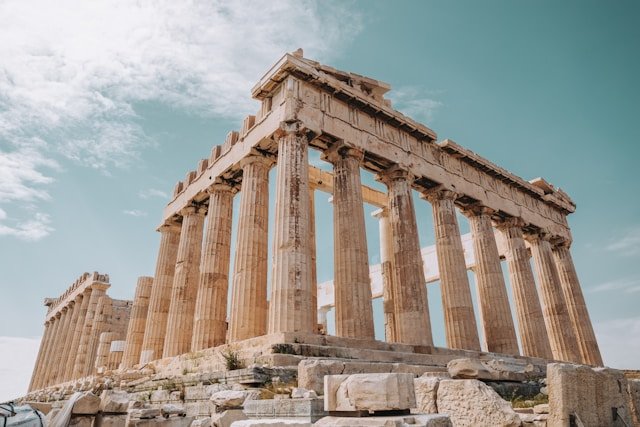
The Parthenon
Atop the Acropolis, the Parthenon stands as a Doric marvel, dedicated to Athena since 438 BC. Its weathered columns, once painted vivid colors, hint at Athens’ past glory despite centuries of wear—war, looting, and all. A UNESCO icon, it’s scaffolded for restoration but still awes. No entry fee beyond the Acropolis ticket—it’s the city’s timeless heartbeat.

Acropolis Museum
Below the Acropolis, the Acropolis Museum gleams with glass and steel, housing treasures like Parthenon friezes since 2009. It’s a modern shrine to ancient Greece—think statues and pottery lit to stun. Entry’s $11 USD, and floor-to-ceiling windows frame the citadel above. It’s a cool, quiet dive into history, perfect after the hill’s heat.
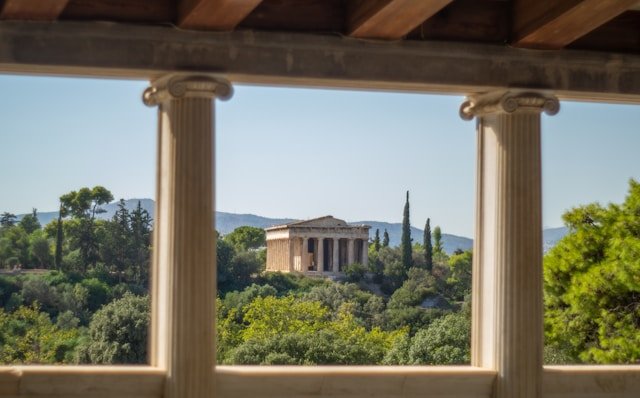
The Ancient Agora
Sprawling in Athens’ core, the Ancient Agora was the city’s bustling heart in Socrates’ day, around 6th century BC. Ruins like the Temple of Hephaestus and Stoa of Attalos whisper of markets and debates. Entry’s $11 USD, or bundled with the Acropolis pass. It’s an open-air time machine—less crowded, more reflective than its hilltop neighbor.
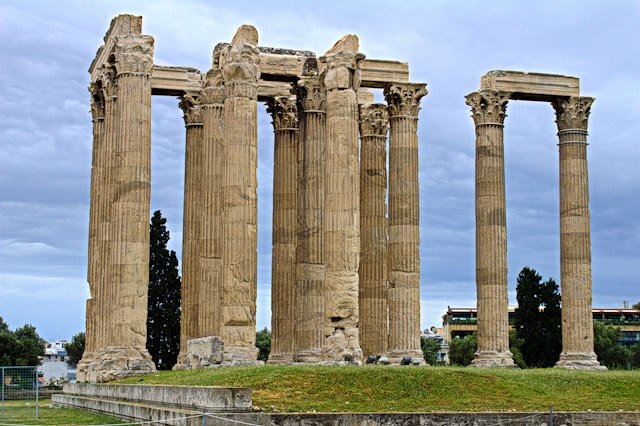
Temple of Olympian Zeus
Once colossal, the Temple of Zeus in central Athens boasts 15 surviving columns from its 6th-century BC start. Built over centuries, it honored the king of gods—Hadrian finished it in 131 AD. Free to view from outside or $6 USD to enter, it’s a quiet giant near busy streets, dwarfed only by its own ancient ambition.
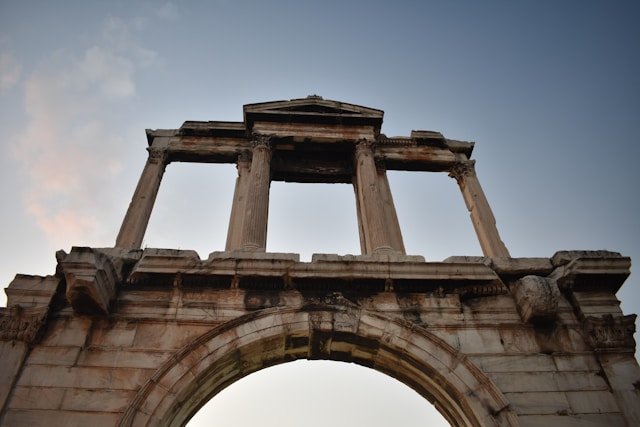
Hadrian's Arch
Framing a busy road, Hadrian’s Arch rises as a marble gateway from 131 AD, honoring Emperor Hadrian. It splits old Athens from his new city, blending Roman flair with Greek roots. Free to admire, it’s a quick photo stop—gritty traffic hums below its elegance. It’s a subtle nod to empires past.
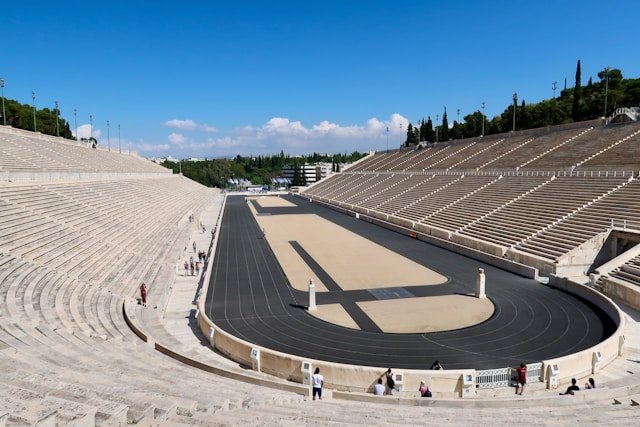
Panathenaic Stadium
Gleaming white, the Panathenaic Stadium hosted the first modern Olympics in 1896, carved from marble in a 4th-century BC horseshoe. It’s the world’s only all-marble stadium, seating 50,000—entry’s $5 USD for a lap or audio tour. Climb the stands for Acropolis views; it’s sporty history with a Greek twist.

Plaka Neighborhood
Tucked below the Acropolis, Plaka neighborhood buzzes with charm—narrow lanes, pastel houses, and tavernas spilling bouzouki tunes. Athens’ oldest district, it’s touristy yet cozy, with roots to antiquity. Free to wander, though souvlaki and ouzo tempt your wallet ($10–$15 USD). It’s the city’s postcard-perfect soul—best at dusk.

National Archaeological Museum
In central Athens, the National Archaeological Museum hoards Greece’s past—think bronze warriors and gold masks from 1863 on. It’s a cavernous trove, from Mycenae to Cyclades, with entry at $13 USD. Less flashy than the Acropolis Museum, it’s raw history—statues and pots galore. A must for artifact nerds.

Lycabettus Hill
Towering over Athens, Lycabettus Hill peaks at 909 feet, offering sunset views that rival the Acropolis. A funicular ($8 USD round-trip) or steep hike gets you there—legends say wolves once roamed it. Free at the top, with a tiny chapel and café, it’s a romantic breather from the urban grind below.
Activities
Day Trip to the Islands
A day trip to nearby islands like Aegina or Hydra offers international tourists a refreshing escape from Athens’ urban bustle, blending adventure with the serene beauty of the Aegean Sea. Aegina, just a 40-minute ferry ride from Piraeus, beckons with its pistachio-laden landscapes, the ancient Temple of Aphaia, and pristine beaches perfect for a swim, while Hydra enchants with its car-free cobblestone streets, donkey-drawn charm, and quaint harbor ideal for a seafood lunch. Ferries are budget-friendly and run frequently, letting you depart in the morning and return by evening. Travelers rave about the chance to explore historic sites, dip into crystal-clear waters, and savor the laid-back island vibe—all in a single, affordable day.
Athens Street Food Tour
Sampling Athens’ vibrant street food scene through a guided or self-led tour is a mouthwatering way to experience Greek culture without straining your wallet. Wander through bustling spots like Varvakios Agora or Monastiraki Square, where the air hums with the sizzle of souvlaki grilling and the aroma of freshly baked koulouri—those iconic sesame bread rings. You’ll taste everything from tender gyros wrapped in warm pita to sticky-sweet loukoumades drizzled with honey, often paired with stories from local vendors or guides about the city’s culinary roots. It’s a budget-friendly feast that delights the senses, earning high praise from foodie tourists eager for an authentic taste of Athens.
Nightlife Exploration
Athens comes alive after dark, offering a nightlife scene that’s as diverse as it is affordable, perfect for international visitors looking to unwind. In Gazi, neon-lit clubs pulse with DJ beats and reasonably priced cocktails, drawing a lively crowd into the early hours, while Psirri and Exarchia offer a more relaxed vibe with intimate bars and tavernas where live rebetiko or jazz spills into the streets. Whether you’re dancing the night away or sipping ouzo with locals, the mix of high-energy hotspots and chill hangouts earns glowing reviews from travelers who love the city’s eclectic, wallet-friendly after-hours charm.
Philosopher’s Walk
Stepping into the world of Socrates and Plato, this walking tour—guided or self-paced—traces the ancient paths where Western philosophy was born, offering a budget-friendly dive into Athens’ intellectual legacy. Start at the Pnyx, the hill where the Athenian assembly debated democracy, then wind through the Agora, once a bustling marketplace where Socrates questioned passersby, and pause at sites like the Academy remnants linked to Plato’s teachings. With just a map or an affordable guide, you’ll connect with history in a tangible way, earning it accolades from curious travelers who appreciate its blend of education and exploration.
Cycling Tour
Seeing Athens on two wheels offers a fresh, affordable perspective, whether you rent bikes independently or join a guided cycling tour that weaves through both famous landmarks and lesser-known gems. Pedal past the Acropolis, along the scenic coastal roads toward the Saronic Gulf, or through quiet neighborhoods rarely seen by tourists, with stops at hidden cafes or panoramic viewpoints. Tours often include helmets and insider tips from local guides, while solo rentals keep costs low for the adventurous. Cyclists love the freedom, the breeze, and the chance to cover more ground, making it a highly rated way to experience Athens’ diverse landscapes.
Explore the National Garden
Tucked beside Syntagma Square, the National Garden is a lush, free-to-enter oasis where international tourists can stroll, picnic, or simply recharge amid 38 acres of greenery. Wander shaded paths lined with orange trees, ancient ruins, and duck-filled ponds, or marvel at the neoclassical Zappeion Hall, especially stunning in spring when flowers bloom in full force. It’s a peaceful retreat from Athens’ hustle, with benches for people-watching and no entry cost, making it a beloved spot for budget travelers who rate it highly for its beauty and accessibility.
Timing Your Flight
Summer in Athens, from June to August, is peak season—think sun-soaked ruins and buzzing Plaka streets. High demand drives up flight prices, and planes fill fast with tourists chasing the Mediterranean glow. Booking early—months ahead if you can—locks in better rates before the rush hits. You’ll pay a premium for the privilege of perfect weather, but the vibrant energy might just be worth it.
For the best bang for your buck, aim for the shoulder seasons: April to May or September to October. The weather’s mild—warm days, cool nights—ideal for climbing the Acropolis without melting. Fewer tourists mean less crowded flights and more reasonable prices, often dipping below summer highs. It’s the Goldilocks zone: not too hot, not too packed, just right for value and comfort.
Hotels
Dining
Tips
Language
SIM Card/Wi-Fi
Dress Code
Tipping
Respect
Transportation
Weather
Value Index
Athens offers a good mix of budget-friendly accommodations, from hostels to reasonably priced hotels, especially if you look beyond the most central areas. Public transportation is both efficient and affordable, with options like daily or multi-day passes that can save money. Dining can be very economical; you can enjoy authentic Greek cuisine at local tavernas or street food at a low cost.
However, peak tourist seasons can inflate prices for accommodations and some attractions, and certain activities or luxury dining experiences can be costly.
